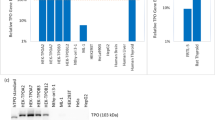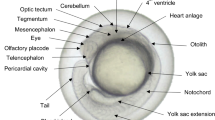Abstract
To determine the endocrine disrupting effect of semicarbazide, an emerging water contaminant, the changes in transcript levels of hepatic estrogen-response genes including vitellogenin-1 (vtg-1), estrogen receptor α (ERα), and estrogen receptor β (ERβ) were measured in male and female zebrafish exposed to semicarbazide with or without exogenous 17β-estradiol (E2). Exposure of male zebrafish to semicarbazide for 96 h or 28 days resulted in no significant induction in hepatic vtg-1, ERα, or ERβ mRNA expression, indicating that semicarbazide has no estrogenic effect. However, a remarkable anti-estrogenic effect of semicarbazide was demonstrated: semicarbazide treatment of female zebrafish for 96 h and 28 days resulted in significant decreases in transcript levels of vtg-1, ERα, and ERβ, as well as decreases in the gonadosomatic index level after 28 days. Moreover, semicarbazide exposure significantly inhibited the induction of vtg-1, ERα and ERβ mRNA by E2 when male zebrafish were co-exposed for 28 days.





Similar content being viewed by others
References
Commission E (2003) Commission Decision 2003/181/EC of 13 March 2003 amending Decision 2002/657/EC as regards the setting of minimum required performance limits (MRPLs) for certain residues in food of animal origin. Off J Eur Commun L 71
Cooper KM, Samsonova JV, Plumpton L, Elliott CT, Kennedy DG (2007) Enzyme immunoassay for semicarbazide—the nitrofuran metabolite and food contaminant. Anal Chim Acta 592:64–71
Davies TS, Lynch BS, Monro AM, Munro IC, Nestmann ER (2000) Rodent carcinogenicity tests need be no longer than 18 months: an analysis based on 210 chemicals in the IARC monographs. Food Chem Toxicol 38:219–235
Davis L, Katsu Y, Iguchi T, Lerner D, Hirano T, Grau E (2010) Transcriptional activity and biological effects of mammalian estrogen receptor ligands on three hepatic estrogen receptors in Mozambique tilapia. J Steroid Biochem Mol Biol 122(4):272–278
EFSA (2003a) Statement of the Scientific Panel on Food Additives, Flavourings, Processing Aids and Materials in Contact with Food Updating the Advice Available on Semicarbazide in Packaged Foods (Adopted 1.10.2003)
EFSA (2003b) Additional advice on semicarbazide, in particular related to baby food. Ad Hoc Expert Group Meeting, 9th October 2003. EFSA/AFC/ad hoc semicarbazide/2-final
Hoenicke K, Gatermann R, Hartig L, Mandix M, Otte S (2004) Formation of semicarbazide (semicarbazide) in food by hypochlorite treatment: is semicarbazide a specific marker for nitrofurazone abuse? Food Addit Contam 21(6):526–537
Hoffmann F, Kloas W (2012) The antiestrogens tamoxifen and fulvestrant abolish estrogenic impacts of 17α-ethinylestradiol on male calling behavior of xenopus laevis. PLoS ONE 7(9):e44715
Jordan V, Dix C, Rowsby L, Prestwich G (1977) Studies on the mechanism of action of the nonsteroidal antioestrogen tamoxifen (ICI 46,474) in the rat. Mol Cell Endocrinol 7(2):177–192
Katsu Y, Bermudez DS, Braun EL, Helbing C, Miyagawa S, Gunderson MP, Kohno S, Bryan TA, Guillette LJ Jr, Iguchi T (2004) Molecular cloning of the estrogen and progesterone receptors of the American alligator. Gen Comp Endocrinol 136(1):122–133
Kloas W, Urbatzka R, Opitz R, Würtz S, Behrends T, Hermelink B, Hofmann F, Jagnytsch O, Kroupova H, Lorenz C (2009) Endocrine disruption in aquatic vertebrates. Ann N Y Acad Sci 1163(1):187–200
Kristensen T, Edwards T, Kohno S, Baatrup E, Guillette L Jr (2007) Fecundity, 17β-estradiol concentrations and expression of vitellogenin and estrogen receptor genes throughout the ovarian cycle in female Eastern mosquito fish from three lakes in Florida. Aquat Toxicol 81(3):245–255
Lazier C, MacKay M (1993) Vitellogenin gene expression in teleost fish. In: Hochachka PW, Mommsen TP (Eds) Biochemistry and Molecular Biology of Fishes, 2, pp 391–405
Lim E, Ding J, Lam T (1991) Estradiol-induced vitellogenin gene expression in a teleost fish, oreochromis aureus. Gen Comp Endocrinol 82(2):206–214
Long X, Nephew KP (2006) Fulvestrant (ICI 182,780)-dependent interacting proteins mediate immobilization and degradation of estrogen receptor-α. J Biol Chem 281(14):9607–9615
Maranghi F, Tassinari R, Lagatta V, Moracci G, Macrì C, Eusepi A, Di Virgilio A, Scattoni M, Calamandrei G (2009) Effects of the food contaminant semicarbazide following oral administration in juvenile Sprague-Dawley rats. Food Chem Toxicol 47(2):472–479
Maranghi F, Tassinari R, Marcoccia D, Altieri I, Catone T, De Angelis G, Testai E, Mastrangelo S, Evandri MG, Bolle P (2010) The food contaminant semicarbazide acts as an endocrine disrupter: evidence from an integrated in vivo in vitro approach. Chem Biol Interact 183(1):40–48
Marlatt VL, Lakoff J, Crump K, Martyniuk CJ, Watt J, Jewell L, Atkinson S, Blais JM, Sherry J, Moon TW (2010) Sex-and tissue-specific effects of waterborne estrogen on estrogen receptor subtypes and E2-mediated gene expression in the reproductive axis of goldfish. Comput Biochem Physiol A 156(1):92–101
Ng TB, Idler DR (1983) Yolk formation and differentiation in teleost fishes. In: Hoar WS, Randall DJ, Donaldson EM (eds) Fish physiology, vol IXA. Academic Press, New York, pp 373–404
Osborne CK, Elledge RM, Fuqua SA (1996) Estrogen receptors in breast cancer therapy. Sci Am 3:32–41
Palstra AP, Schnabel D, Nieveen MC, Spaink HP, van den Thillart GE (2010) Temporal expression of hepatic estrogen receptor 1, vitellogenin1 and vitellogenin 2 in European silver eels. Gen Comp Endocrinol 166(1):1–11
Pereira A, Donato J, De Nucci G (2004) Implications of the use of semicarbazide as a metabolic target of nitrofurazone contamination in coated products. Food Addit Contam 21(1):63–69
Philips A, Chalbos D, Rochefort H (1993) Estradiol increases and anti-estrogens antagonize the growth factor-induced activator protein-1 activity in MCF-7 breast cancer cells without affecting c-fos and c-jun synthesis. J Biol Chem 268(19):14103–14108
Richard A, Dixona RA, Daneel F (2002) Genistein. Phytochemistry 60(3):205–211
Rose J, Holbech H, Lindholst C, Nørum U, Povlsen A, Korsgaard B, Bjerregaard P (2002) Vitellogenin induction by 17β-estradiol and 17α-ethinylestradiol in male zebrafish (Danio rerio). Comput Biochem Physiol C 131(4):531–539
Segner H (2009) Zebrafish (Danio rerio) as a model organism for investigating endocrine disruption. Comput Biochem Physiol C 149(2):187–195
Sohoni P, Tyler C, Hurd K, Caunter J, Hetheridge M, Williams T, Woods C, Evans M, Toy R, Gargas M (2001) Reproductive effects of long-term exposure to bisphenol A in the fathead minnow (Pimephales promelas). Environ Sci Technol 35(14):2917–2925
Sun L, Wen L, Shao X, Qian H, Jin Y, Liu W, Fu Z (2010) Screening of chemicals with anti-estrogenic activity using in vitro and in vivo vitellogenin induction responses in zebrafish (Danio rerio). Chemosphere 78(7):793–799
Sun L, Shao X, Hu X, Chi J, Jin Y, Ye W, Fu Z (2011) Transcriptional responses in Japanese medaka (Oryzias latipes) exposed to binary mixtures of an estrogen and anti-estrogens. Aquat Toxicol 105(3):629–639
Toth B, Shimizu H, Erickson J (1975) Carbamylhydrazine hydrochloride as a lung and blood vessel tumour inducer in Swiss mice. Eur J Cancer 11(1):17–22
USEPA (1996) Ecological Effects Test Guidelines: OPPTS 850.1075 Fish Acute Toxicity Test, Freshwater and Marine. EPA 712-C-96-118, April 1996. Washington, DC: U.S. Environmental Protection Agency
USEPA (2004) http://www.epa.gov/dfe/pubs/flameret/altrep-v1/altrep-v1a-app-b.pdf (Updated September 2004)
Wahli W (1988) Evolution and expression of vitellogenin genes. Trends Genet 4(8):227–232
Wallace RA (1985) Vitellogenesis and oocyte growth in nonmammalian vertebrates. In: Browder LW (ed) Developmental biology, vol 1. Plenum, New York, pp 127–177
Wang H, Tan JT, Emelyanov A, Korzh V, Gong Z (2005) Hepatic and extrahepatic expression of vitellogenin genes in the zebrafish, Danio rerio. Gene 356:91–100
Xu YJ, Sun YZ, Song XK, Tian X, Gong XH, Zhang XZ, Zhang LM (2010) Survey of semicarbazide contamination in coastal waters adjacent to the chaohe river estuary. Oceanologia Et Limnologia Sinica 41(4):1–5
Yan Z, Lu G, He J (2012) Reciprocal inhibiting interactive mechanism between the estrogen receptor and aryl hydrocarbon receptor signaling pathways in goldfish (Carassius auratus) exposed to 17β-estradiol and benzo[a]pyrene. Comput Biochem Physiol C 156(1):17–23
Acknowledgments
This work was supported by the National Natural Science Foundation of China [31170322].
Author information
Authors and Affiliations
Corresponding author
Rights and permissions
About this article
Cite this article
Gao, S., Wang, W., Tian, H. et al. An Emerging Water Contaminant, Semicarbazide, Exerts an Anti-estrogenic Effect in Zebrafish (Danio rerio). Bull Environ Contam Toxicol 93, 280–288 (2014). https://doi.org/10.1007/s00128-014-1305-7
Received:
Accepted:
Published:
Issue Date:
DOI: https://doi.org/10.1007/s00128-014-1305-7




